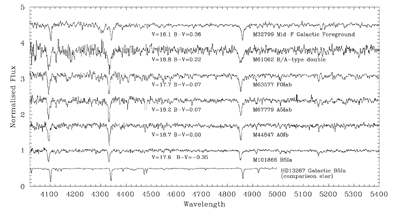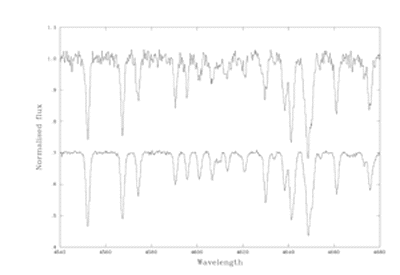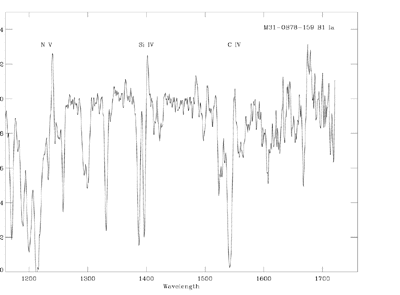| The ING Newsletter | No. 1, September 1999 |
| GENERAL | TELESCOPES AND INSTRUMENTATION | OTHER NEWS FROM ING | TELESCOPE TIME |
Previous: The Isaac Newton Group's Wide Field Survey. Status of the Survey and Associated Data Pipeline | Up: Table of Contents | Next: The Cluster of Galaxies Abell 2219 as seen by CIRSI
Extragalactic Stellar Spectroscopy
D.J. Lennon (ING),
S.J. Smartt (ING), P.L. Dufton (QUB), A. Herrero (IAC), R.-P. Kudritzki
(Uni-Sternwarte, Munich), K. Venn (Macalaster College), J. McCarthy (CalTech)
The advent of large 8–10m telescopes heralds a new age in stellar astronomy. It is now possible to carry out detailed spectroscopic observations at high resolution of the brightest stars of galaxies in the Local Group, and it is envisaged that intermediate resolution observations will be extended to stars in the nearest galaxy clusters such as Virgo and Fornax. For some years the authors have been carrying out the groundwork involved in identifying young massive supergiant stars in nearby resolved galaxies, with a view to performing follow-up detailed studies of selected samples. In this article we summarize the contribution that the William Herschel Telescope has made to this project, and further, show that even a 4.2m telescope with a blue sensitive, large format CCD at a good site with dependable sub-arcsecond seeing can make an important contribution to the detailed study of our nearest spiral neighbours M31 and M33.
We have two primary objectives in the study of massive stars in nearby galaxies; one is to use these objects as probes of the present day chemical composition and the second, which will not be discussed in detail here, is their use as standard candles. Blue supergiant stars have absolute visual magnitudes in the range –7 to –10, and may be conveniently split into B-type and A-type stars. The B-type objects typically have broader lines (with widths corresponding to Doppler velocities of 50–100km/s) and have many strong isolated lines of light elements such as C, N, O, Si, and Mg. A-type supergiants on the other hand have somewhat narrower line-widths and many weak lines of Fe-group, s- and r-process elements. Hence a detailed analysis of a sample of these objects can provide very powerful constraints on models of a galaxy's evolution. However as AB-type supergiants are relatively young stars, we are restricted to galaxies with active star formation, typically spirals and dwarf irregular galaxies. In the rest of this article we will concentrate on some work which has been performed on M31, the largest and most luminous galaxy in the Local Group.
The brightest stars in M31 were originally studied spectroscopically by Humphreys (1979), from a sample selected from photographic photometry. The selection was performed on the basis of magnitude and colour, and we have essentially repeated this selection using the CCD photometric catalogue of Magnier (Magnier et al., 1992 and Haiman et al., 1994). Our colour magnitude diagrams covered 16.0<V<18.5, and colour range B–V<0.4, within which single O, B, A and F-type supergiants members of M31 should lie. These criteria resulted in a sample of several hundred blue supergiant candidates. At the distance of M31, 1 arcsec corresponds to 3.4 pc and hence some of our chosen objects turn out to be composites, with spectral signatures of two (or more) stars of differing spectral types. Additionally the highly variable reddening across M31 requires that the red cut-off is relatively high, which then encroaches on the colour-magnitude region occupied by Galactic foreground late types and subdwarfs. Hence low-resolution spectroscopy is an essential filter for target identification.
The combination of AutoFib2 and
WYFFOS on the WHT is ideal for this kind of project – approximately 90
science fibres can be placed within the 1 degree un-vignetted field of
view at Prime. We match the Magnier CCD colours of our selected objects
to the astrometric coordinates from APM plate scans to provide the necessary
accuracy (0.2 arcsec) for AF2 fibre placement and consistency with fiducial
guide star positions. We have already had a successful observing run in
December 1997 when we obtained spectra of approximately 100 supergiants
in M31, with another run scheduled in autumn 1999. With a spectral resolution
of 2.5Å, we are able to reliably classify large numbers of targets,
and typical results from these observations are shown in Figure 1.
 |
| Figure 1. Four massive supergiants spanning the spectral range mid-B to mid-F are shown from the AF2/WYFFOS run in December 1997. Their spectra are velocity shifted by approximately –550km/s, consistent with membership in the SW spiral arms of the galaxy, and the visible lines are consistent with them being single evolved massive stars with the given spectral types. We show a nearby Galactic spectral standard (HD13267), convolved to the same resolution as the WYFFOS spectra. Visible in the B-type spectrum are lines of HeI, SiII and MgII, and as HeI disappears in the later types SiII 4128–30 and MgII become stronger and FeII (e.g. 4173–8) starts to appear. The FeII lines are clearly visible in the F0Ib spectrum along with additional lines of SrII and TiII. Also shown are examples of a composite spectra, M61062 (the hydrogen lines are clearly split, and of approximately twice the strength of late-B early A-types) and a late-type Galactic foreground star, M32799). [ GIF | TIFF ] |
Follow-up ground-based high resolution
spectroscopy is also planned and in fact this has already begun with some
successful runs on the Keck I with the HIRES spectrograph (McCarthy et
al. 1997, Venn et al. 1998). For M31 however, a lot can be achieved for
B-type supergiants with intermediate resolution spectroscopy, concentrating
on the strong lines in the earlier spectral types. Last year, we
were fortunate enough to have a WHT/ISIS observing run with sub-arcsecond
seeing (0.4 arcsec at one point), during which we obtained medium resolution
(1Å FWHM spectral resolution) spectra of 18th magnitude supergiants.
Early B-type supergiants have a strong tendency to show relatively broad
metal line widths (e.g. virtually always having velocity broadening of
greater than 60 km/s; Howarth et al., 1997) thus a spectral resolution
of 1Å is sufficient to satisfactorily sample the line widths. One
setting with the new EEV42-80 CCD on the blue arm of ISIS allows coverage
from 3960 to 4720Å together with excellent efficiency. This provides
all the blue atmospheric diagnostics required for model atmosphere analyses
– allowing detailed abundance determinations in stars down to V~18.5 on
a 4 m telescope. The quality of the spectra are shown in Figure 2, and
compared to the spectrum of a nearby, Galactic standard B-type supergiant.
This demonstrates quite clearly that the metallicities of the M31 supergiants
are close to solar, which is not entirely unexpected given that the galactocentric
radius sampled by our objects is expected to have roughly solar metallicity
from HII region results (Blair et al., 1982).
 |
| Figure 2. This figure compares spectra of the M31 and Galactic B1Ia supergiants OB78-159 (top) and HD194279 (bottom). The spectral range covered contains the SiIII triplet at 4553/4567/4574Å, and a number of OII and NII lines between 4590 and 4680Å. The M31 spectrum is a 1 hour exposure obtained with ISIS on the WHT at a resolution of 5000 in half-arcsecond seeing, the star has a visual magnitude of 17.97. The difference in the line strength ratios of OII 4590/4596Å and the NII lines at 4601/4607 for example, is due to a slight temperature difference, OB78-159 being the hotter star. The detailed model atmosphere analysis of OB78-159 is underway, however we can already see that the metal line spectrum is consistent with a composition similar to supergiants in the solar neighbourhood. [ GIF | TIFF ] |
Blue supergiants can also be used
as standard candles as their mass-loss rates provide an estimate of their
luminosity. The most important diagnostic of mass-loss in this context
is the profile of the Ha line, which for the most luminous supergiants
is in emission. Ideally one also requires observational constraints
on the wind velocity law and terminal velocity which are best derived from
ultra-violet spectra which contain strong wind lines. M31, together
with the Magellanic Clouds, are important test beds for this approach.
The most luminous stars are within the reach of the Hubble Space Telescope
(HST) and its UV spectroscopic instruments and there is an ongoing HST
spectroscopic campaign to obtain UV spectra of blue supergiants which have
been well observed from the ground. The first such spectrum from
the M31 campaign, obtained in January this year, is shown in Figure 3 for
the B1Ia supergiant OB78-159 discussed above.
 |
| Figure 3. HST/STIS spectrum of OB78-159 obtained in 3 orbits using the G140L grating, long slit and FUV-MAMA detector and a total exposure time of approximately 8000 seconds. Strong P-Cygni wind lines of NV, SiIV and CIV are clearly visible and can be used to derive the terminal velocity of the stellar wind. [ GIF | TIFF ] |
This project is continuing with the ING's wide field imaging and spectroscopic facilities, the Wide Field Camera and AF2/WYFFOS, which will lead to the detailed follow-up programs. We can already use ISIS on the WHT for detailed analysis of the brightest stars in interesting nearby galaxies such as the other Local Group spiral M33 and the dwarf irregulars like IC10, IC1613 and NGC6822. For the A-type supergiants (at higher resolution), and objects further afield we plan to extend this work using facilties on Gemini North (GMOS-N) and South (GMOS-S, HROS).
References:
Blair, W. P., Kirshner, R. P.,
Chevalier, R. A., 1982, A&A, 254, 50
Haiman, Z., Magnier, E., Lewin,
W. H. G., Lester, R. R., Van Paradijs, J., Hasinger, G., Pietsch, W., Supper,
R., Truemper, J., 1994, A&A, 286, 725
Howarth, I. D., Siebert, K. W.,
Hussain, G. A. J., Prinja, R. K., 1997, MNRAS, 284, 265
Humphreys, R. M., 1979, ApJ,
234,
854
Magnier, E. A., Lewin, W. H.
G., Van Paradijs, J., Hasinger, G., Jain, A., Pietsch, W., Truemper, J.,
1992, A&AS, 96, 379
McCarthy, J. K., Kudritzki, Rolf-Peter,
Lennon, D. J., Venn, K. A., Puls, J., 1997, ApJ, 482, 757
Venn, K. A., McCarthy, J. K.,
Lennon, D. J., Kudritzki, R. P., 1998, Boulder-Munich II: Properties of
Hot, Luminous Stars, edited by Ian Howarth, ASP Conference Series,
131
(San Francisco), 1998, p. 177 ¤
Email contact: Danny Lennon (djl@ing.iac.es)
Previous: The Isaac Newton Group's Wide Field Survey. Status of the Survey and Associated Data Pipeline | Up: Table of Contents | Next: The Cluster of Galaxies Abell 2219 as seen by CIRSI
| GENERAL | TELESCOPES AND INSTRUMENTATION | OTHER NEWS FROM ING | TELESCOPE TIME |